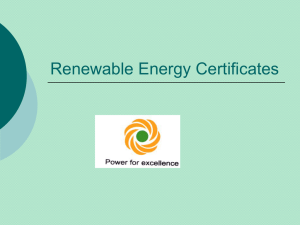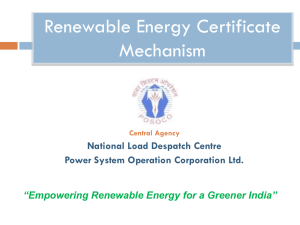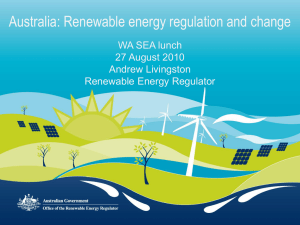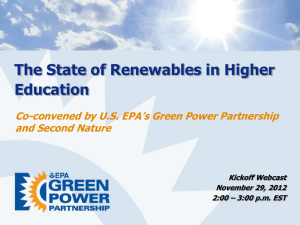Dear Green-e Participant
advertisement
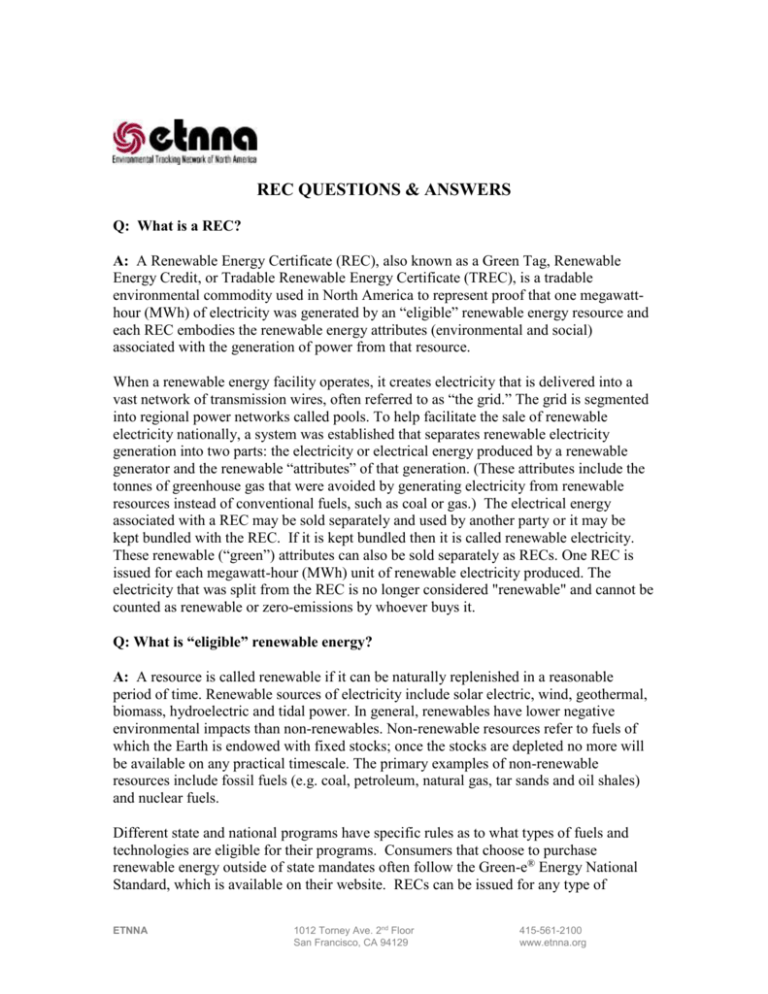
REC QUESTIONS & ANSWERS Q: What is a REC? A: A Renewable Energy Certificate (REC), also known as a Green Tag, Renewable Energy Credit, or Tradable Renewable Energy Certificate (TREC), is a tradable environmental commodity used in North America to represent proof that one megawatthour (MWh) of electricity was generated by an “eligible” renewable energy resource and each REC embodies the renewable energy attributes (environmental and social) associated with the generation of power from that resource. When a renewable energy facility operates, it creates electricity that is delivered into a vast network of transmission wires, often referred to as “the grid.” The grid is segmented into regional power networks called pools. To help facilitate the sale of renewable electricity nationally, a system was established that separates renewable electricity generation into two parts: the electricity or electrical energy produced by a renewable generator and the renewable “attributes” of that generation. (These attributes include the tonnes of greenhouse gas that were avoided by generating electricity from renewable resources instead of conventional fuels, such as coal or gas.) The electrical energy associated with a REC may be sold separately and used by another party or it may be kept bundled with the REC. If it is kept bundled then it is called renewable electricity. These renewable (“green”) attributes can also be sold separately as RECs. One REC is issued for each megawatt-hour (MWh) unit of renewable electricity produced. The electricity that was split from the REC is no longer considered "renewable" and cannot be counted as renewable or zero-emissions by whoever buys it. Q: What is “eligible” renewable energy? A: A resource is called renewable if it can be naturally replenished in a reasonable period of time. Renewable sources of electricity include solar electric, wind, geothermal, biomass, hydroelectric and tidal power. In general, renewables have lower negative environmental impacts than non-renewables. Non-renewable resources refer to fuels of which the Earth is endowed with fixed stocks; once the stocks are depleted no more will be available on any practical timescale. The primary examples of non-renewable resources include fossil fuels (e.g. coal, petroleum, natural gas, tar sands and oil shales) and nuclear fuels. Different state and national programs have specific rules as to what types of fuels and technologies are eligible for their programs. Consumers that choose to purchase renewable energy outside of state mandates often follow the Green-e® Energy National Standard, which is available on their website. RECs can be issued for any type of ETNNA 1012 Torney Ave. 2nd Floor San Francisco, CA 94129 415-561-2100 www.etnna.org renewable technology or fuel, but their use is limited by the type of renewable “eligible” for credit under the specific program to which the REC is being applied. The data that accompany each REC allows program administrators to make those distinctions. Q: How did RECs get started? A: Several things happened in the late 1990’s that resulted in the creation of the REC. Three of the most significant were: (1) Interest by Federal agencies and some businesses and industries in purchasing renewable energy; (2) passage of state renewable energy mandates; and (3) the difficulty encountered in obtaining a power purchase agreement for renewable energy projects that would pay enough to cover the cost of the renewable project plus a reasonable return on investment. 1. An Executive Order was issued by then President Clinton directing Federal agencies to make every effort to procure renewable energy. One of the most enthusiastic of those agencies was the U.S. Environmental Protection Agency (EPA). The EPA purchases large amounts of electricity for their facilities located throughout the country, and they were eager to modify their electricity purchases from conventional fossil generated power to renewable power. However, that turned out to be more difficult than expected. Renewable power was not necessarily generated in the same locations as EPA facilities. Moreover, some utilities were not willing to allow renewable energy generators to use the utility’s transmission and distribution system to move their power (called wheeling) from where it was generated to the facility that wanted to buy it. In some cases the renewable power would have to be “wheeled” across several utility service areas increasing the cost of that power substantially. Moreover since many of the EPA facilities were relatively small, the transaction costs of negotiating the wheeling and purchase agreements were too great to justify. At this same time (the late 1990’s) a number of companies were gaining market recognition for purchasing renewable energy rather than conventional power. This recognition by programs such as the EPA’s Green Power Partnership helped increase demand for renewable energy. But as with Federal procurement of renewables, many companies that were willing and interested in buying renewable power were unable to do so because it was not offered in their geographic area. 2. In parallel with these events, a number of states began to adopt mandatory renewable energy targets for their public utilities. These policies, called Renewable Portfolio Standards (RPS), required that each utility acquire a specific percentage of their electrical energy from eligible renewable resources (i.e., the specific types of generating resources that the state specified in the law). However, since you can’t track electrons, and contract audits are time consuming and expensive, a mechanism was needed that could provide proof of the amount of renewable energy a utility had purchased. ETNNA 1012 Torney Ave. 2nd Floor San Francisco, CA 94129 415-561-2100 www.etnna.org 2 3. There was interest in building and operating renewable generating facilities. And there was interest on the part of electricity consumers to purchase renewable electricity, but the consumers that wanted to purchase it were not necessarily located where utilities wanted to sell it or where private sector companies were allowed to sell it. Utilities might be willing to purchase renewable power for the same price as conventional power but that still left a negative difference between what developers needed and the payment they would receive. The renewable energy certificate (REC) was created to meet all these needs. The concept was to issue a REC for each MWh of renewable power that was generated. It could then be sold along with the power, such as when an electric utility purchased renewable energy to meet their RPS obligations, and the certificate could be offered to regulators as proof of that energy purchase. Or the REC could be sold separately to a Federal agency or private company or individual household that did not have direct access to renewable energy. When the REC, representing the environmental benefits of renewable power generation, is combined with a MWh of conventional power, the purchaser can then claim to have electricity that does not emit greenhouse gases. However, this is only valid as long as no one else, including the generator of the power from which those environmental attributes were stripped, is claiming the same attributes. A U.S. nonprofit organization, the Bonneville Environmental Foundation (BEF), was instrumental in starting the voluntary market for RECs with the first retail REC agreement in 2000 between BEF and EPA Region X. Q: How are RECs created? A: Today, most RECs are created by a regional tracking system such as the New England Generation Information System (NE/GIS), the Pennsylvania, New Jersey and Maryland Generation Attribute Tracking System (PJM/GATS), the Energy Reliability Council of Texas (ERCOT), the Midwest Regional Tracking System (M-RETS) or the Western Renewable Energy Generation Information System (WREGIS). These are all quasi-governmental entities created to issue and track certificates of generation located within their jurisdiction. There is also a plan by the APX Company to launch a default tracking system/registry for projects located in a region not covered by the existing tracking systems. All of these tracking systems, with the exception of APX, are associated with a regional electricity reliability council and have on-going relationships with the electric utilities, balancing authorities and transmission system operators in their region. The tracking systems regularly receive electronic information regarding the net energy output of each renewable energy project registered in their system. These data are reported by independent qualified reporting agencies that meet the tracking system’s specifications. For each MWh of net generation reported to the tracking system, the system electronically creates a REC with a unique identification number to make sure it is not double counted. Those RECs are deposited into the generator’s electronic account and can be transferred to others through contract or sales. Those who are buying the RECs ETNNA 1012 Torney Ave. 2nd Floor San Francisco, CA 94129 415-561-2100 www.etnna.org 3 open their own accounts into which RECs can be transferred and the system operates like electronic banking. As with electronic banking, the actual business transaction takes place outside the tracking system. The tracking system simply acts as an accounting system for issuing, tracking and retiring RECs. A key element of RECs is the electronic data that accompany each REC. Those data describe such things as the type of generating facility from which the REC was produced (e.g. wind or solar), the date the facility became operational, the date the REC was produced, the state in which the project is located, and so forth. This information is available to potential buyers and regulators so they are able to select the type of REC that meets their company or state’s program needs. Q: How are RECs tracked? A: As mentioned previously, each REC has a unique identification number that can only be in one account at any point in time. Account holders can create sub-accounts into which they can deposit RECs to be used for special purposes (such as compliance with a state RPS program or sales to end-use customers. According to regional tracking system participation rules, a generator can only be registered with one tracking system to avoid double counting of their energy output. However, non-generator account holders can have accounts in as many tracking systems as are desirable for their business. When a claim is made using a REC that REC is then retired. For example, a utility RPS account that is used to prove utility compliance with the mandate is a type of retirement account. Once RECs are deposited in that account they cannot be taken out or reused for some other purpose. The same is true for RECs sold to end user customers who then can claim they purchased renewable power. The RECs can change hands a number of times as long as none of the intermediaries make a claim using the REC. But once a claim is made against the REC that REC’s identification number is retired, and it can not be used again. Q: How are RECs used? A: There are two primary REC markets in North America, the compliance market and the voluntary market. Compliance Market – The compliance market serves 29 US state RPS programs. Most state RPS administrators require their utilities to secure RECs to demonstrate compliance with the RPS requirement. So, for example, in California each electric service company would need to have sufficient RECs in their RPS Account equivalent to 20 percent of their electricity sales by 2010. Voluntary Market – Voluntary renewable energy markets are where consumers have a choice and they choose to buy renewable power or RECs for environmental, social or other reasons. The REC not only provides proof that the consumer has purchased renewables, but the REC can also “green” the conventional electricity the consumer ETNNA 1012 Torney Ave. 2nd Floor San Francisco, CA 94129 415-561-2100 www.etnna.org 4 uses or, if it meets the specific criteria, the REC can be converted into tonnes of carbon avoided and used to reduce the consumer’s greenhouse gas footprint. Q: How are the RECs priced, and where does the money go? A: The market sets the price for RECs based on supply and demand. Most states with RPS programs require the RECs come from projects located within their state or an adjacent state. Since some states have more renewable energy projects than others, the price for compliance RECs is higher in states with greater demand than supply. Also, compliance markets have seasonal fluctuations so for instance RECs being sold near the end of the annual RPS cycle, as the RPS audit approaches will often bring a higher price than those sold early in the RPS cycle. Since the voluntary REC market is national or sometimes international in scope, the prices for RECs in the voluntary market tend to be more stable and have a smaller range of prices than does the compliance market. Finally, RECs from higher cost, higher demand or more limited projects like solar tend to receive a higher price than RECs from lower cost or lower demand resources like landfill gas projects. Regardless of the market, most of the price paid for the REC ultimately goes back to the renewable generator. The renewable generator is the one who is issued the REC to begin with and does not need to sell it unless s/he receives sufficient revenue to cover the difference between the cost of generating the power and the price being paid for the generic electricity being sold without the REC. Moreover, the additional revenue stream resulting from REC sales provides an additional incentive for the construction of more renewable generation projects. Q: How are REC transactions verified? A: The question often arises, “how do I know I am getting what I am paying for? RECs are a pretty abstract product” The answer is to buy RECs from entities that participate in an independent third party sponsored program that verifies its participant’s claims. The largest and best known of these programs is Green-e® Energy, administered by the nonprofit Center for Resource Solutions. Green-e Energy requires participating sellers (known as marketers) to meet strict eligibility requirements and undergo annual audits to ensure that (1) RECs are not being double counted or double sold; (2) the consumer is receiving “fresh” RECs (e.g. RECs created during a specified period of time); and (3) the RECs are of the exact type that the marketer claimed to be selling (for example, RECs from a wind farm located on an Indian reservation, or RECs from solar PV facilities). The audits should be undertaken by certified accountants and auditors following specific audit protocols and then reviewed by the program administrator to evaluate the results. In this example, the audit reports are sent to Green-e for review to make sure the participating company met their responsibilities. All participating companies and the results of their annual audit are posted on the Green-e website. ETNNA 1012 Torney Ave. 2nd Floor San Francisco, CA 94129 415-561-2100 www.etnna.org 5

